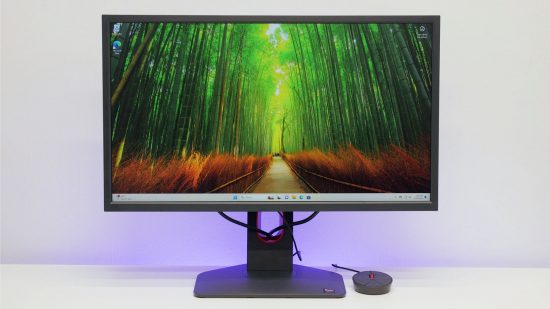Our Verdict
With its blistering fast refresh rate and motion blur-stomping DyAc mode, the XL2566K is indeed a competitive FPS gamers dream screen. That's almost all the more true thanks to the fact that its TN LCD panel doesn't produce amazing contrast or dazzling colors. The two big caveats here, though, are that the 1080p resolution isn't suited to more graphically rich games taking place on large maps - it's a bit coarse for Apex Legends or particularly Warzone. Plus, it's very expensive for what is purely a gaming tool - this isn't the one panel to rule them all.
- Best in class gaming performance
- Useful wired remote control
- Convenient extra features
- Low resolution
- Expensive
- Poor image quality outside of comp gaming
BenQ’s Zowie brand has long held favor in the competitive gaming scene for its focus on no-frills gaming performance, with its mice and monitors often seen as the best in their class. Several of its past gaming screens have been go-to options for major tournaments for all manner of games and its latest top-tier FPS screen, the BenQ Zowie XL2566K has been chosen for the PGL CS2 Major. Is this screen worthy of its tournament placement? Let’s take a look.
In line for a place on our best gaming monitor list as the best gaming monitor for CS2, the BenQ Zowie XL2566K has some stiff competition from the latest OLED panels when it comes to pure responsiveness. The likes of the MSI MPG 271QRK offer super fast response times, a higher resolution, and much better image quality overall. But, even though this panel is expensive, OLEDs cost even more, so this should still be a top choice for those seeking a pure gaming screen.
Why you can trust our advice ✔ At PCGamesN, our experts spend hours testing hardware and reviewing games and VPNs. We share honest, unbiased opinions to help you buy the best. Find out how we test.
BenQ Zowie XL2566K specs
| Size | 24.5-inch |
| Resolution | 1,920 x 1,080 |
| Refresh rate | 360Hz |
| Panel type | TN LCD |
| Variable refresh rate | Yes (FreeSync Premium Pro) |
| HDR | No |
| Curve | No |
| Ports | DisplayPort 1.4 2 x HDMI 2.0 Headphone out |
| Extras | DyAc backlight strobing |
| Price | $799.99 (£999.99) |
BenQ Zowie XL2566K features
Aside from its screen, the BenQ Zowie XL2566K has a fairly basic feature set, but it’s enhanced by a couple of useful practical extras.
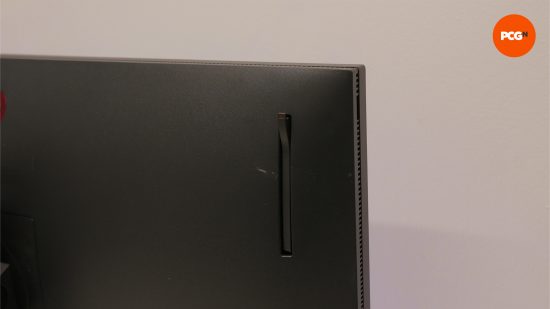
The back of the panel is home to a flip-down headphone arm that offers a genuinely convenient place to stow your headset between gaming sessions. The actual arm is quite delicate, though, so you’ll want to make sure you don’t rage-stow your headset to avoid the risk of snapping it.
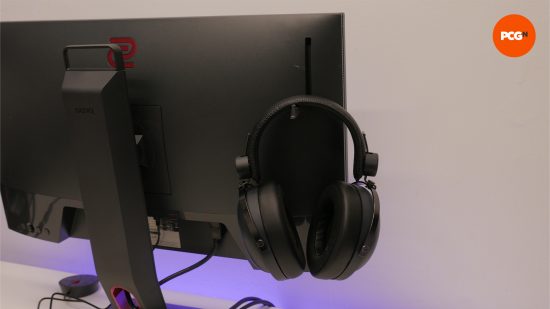
Another useful addition is a carry handle on the top of the main stand. The display isn’t particularly large or heavy anyway, but this makes it just that bit easier to cart around, which is a genuine consideration for a tournament-grade display such as this one.
Similarly, the large opening in the stand for cable routing makes the setup process quick and easy – there are none of the much more fiddly cable arrangements you find on some monitors.
Along similar lines, the stand itself offers a full selection of adjustments, so you can pivot the display into portrait mode for easy access to the ports, as well as rotate it left to right, adjust the height of the panel, and tilt it up and down too.
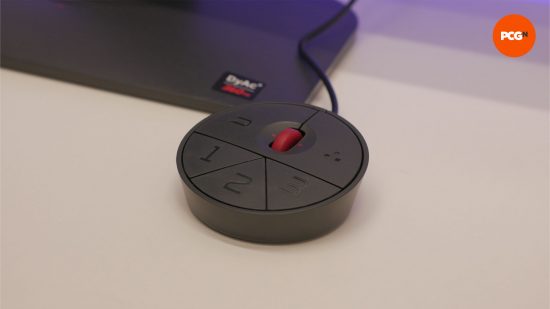
Yet more usefulness comes from the addition of a wired remote control. This saves you from fumbling around the back of the display for the onscreen menu controls, and it even adds a scroll wheel for quicker navigation and changing of some settings. It also has shortcut keys for three presets and a button for quickly changing the input.
Those inputs consist of a standard DisplayPort 1.4 connector and two HDMI 2.0 ports. Notably, you don’t get either a USB-C port for easily hooking up a laptop or – more damningly – any sort of USB hub. Monitor-mounted USB hubs generally offer a convenient way to arrange your peripheral cables, and it’s a shame to see it omitted on an expensive display. At least the monitor includes an internal power supply, so you don’t have to worry about a power brick cluttering your desk.
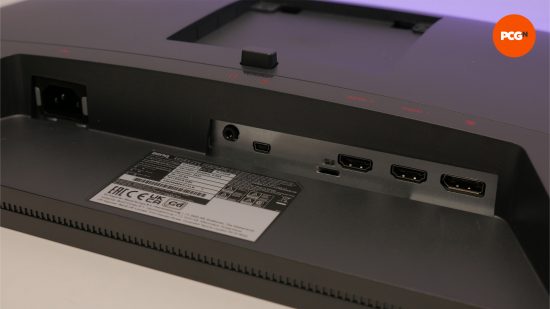
Also included with this display are wings that attach to the side of the screen. These offer a degree of privacy to block players from being able to see each other’s screens in LANs, and can provide some distraction/glare mitigation. However, there’s no top panel to reduce glare from above, as you commonly see on professional-grade image/film editing displays.
As for the panel itself, this is of course the heart of this display. It’s just a basic TN LCD, which means it has the poor viewing angles, middling image quality, and basic color reproduction for which this panel technology is known. But, with its maximum 360Hz refresh rate and the fast response time of TN (interestingly, BenQ Zowie doesn’t make a claim about the specific response time of the panel), you get a strong starting point for a speedy gaming panel.
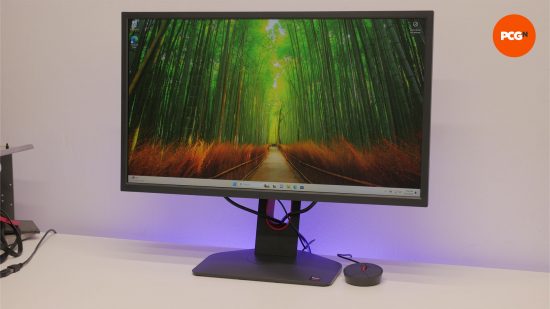
The 24.5-inch size and 1080p resolution are standard specs for the sort of games this display targets, but it’s a far cry from the larger, higher-resolution screens you might expect to get for the price of this panel.
The added secret sauce with this display is its DyAc or Dynamic Accuracy feature, which is the company’s term for a mode that strobes the LCD’s backlight on and off. This helps to reduce eye tracking motion blur, in turn making it easier to track moving targets. At least that’s the theory. We’ll come to the practice later.
BenQ Zowie XL2566K design
This is a very utilitarian looking monitor. Aside from the signature red accents of the BenQ Zowie brand, the whole screen is finished in a very plain matte black plastic with chunky bezels that are a far cry from the sleek edges of the latest OLED panels.
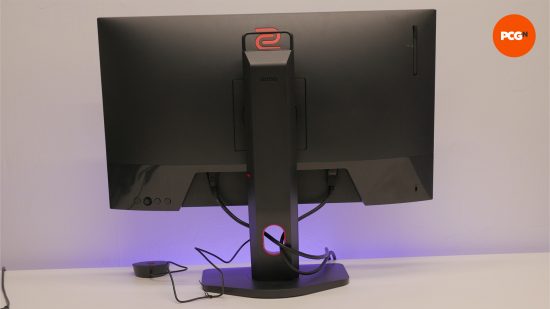
As for those red accents, there’s a large red plastic oval shape inset into the upright section of the stand, surrounding the cable tidying hole. Then there are red arrows on the stand’s base that offer up a hilariously pointless angle indicator. There’s a slightly more useful red height indicator dial on the stand that you can set to your preferred level, which then makes it easy to line up the display with this mark.
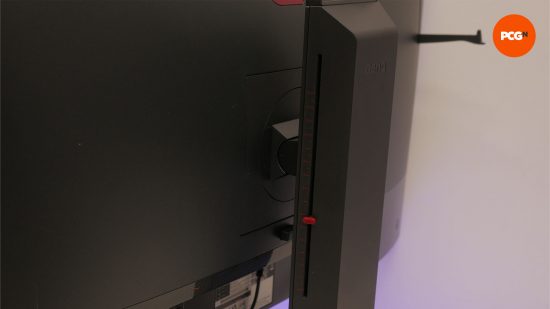
Also round the back is a red Zowie logo – not backlit, as there’s no RGB here – and finally the scroll wheel on the remote control is finished in red too. As relatively easily visible markers for useful functions, the accents are a somewhat welcome addition, though as an overall aesthetic, it’s not much to write home about.
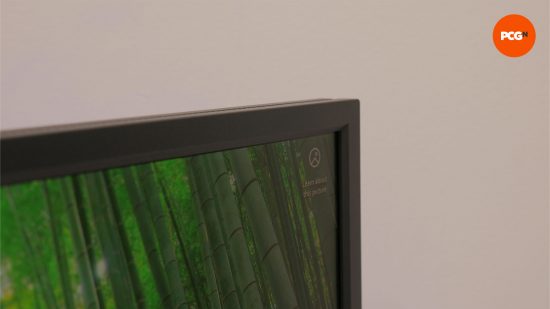
In terms of ruggedness, though, the chunky bezels ensure the screen gets lots of support and protection. Generally, the whole unit is built in a way that makes it easy to move around, and it feels like the screen will survive the rigors of that move.
BenQ Zowie XL2566K menus
The XL2566K’s menus are comprehensive, with a lot of gaming tweaks available, including turning on/off DyAc (with High and Premium levels), adjusting response time (which BenQ Zowie calls Advanced Motion Accelerator [AMA]), and plenty of options for adjusting the image quality of the panel too.
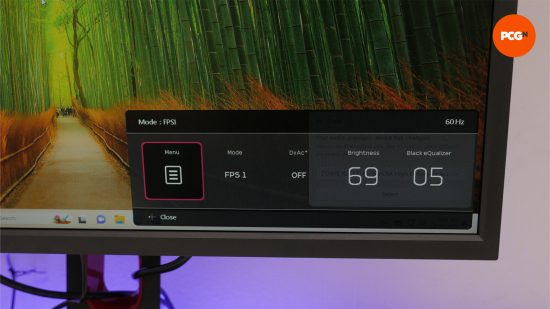
As is so often the case these days, the display ships in an Eco mode that limits the brightness, but once you’ve accepted that you’re happy to crank up the watts, the display opens up to offer a whole host of preset game modes, with the default setting of the display being FPS1. This is the mode supposedly optimized for CS:GO, but it’s not the best when it comes to overall image quality, so you’ll want to make sure you play around to find the settings that you prefer for non-gaming scenarios.
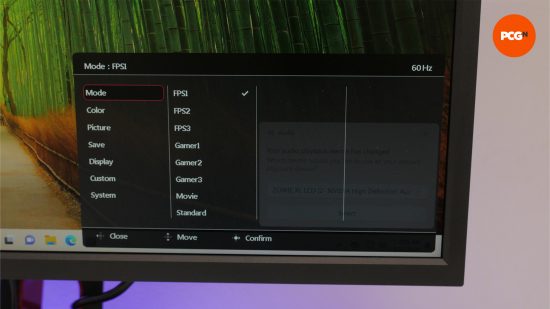
Notably, the remote control really does make it so much easier to set up the display and change settings on the fly. The scroll wheel, which also tilts left and right to act as a D-pad, makes navigation fast, and the 1/2/3 preset buttons mean that, once you’ve set up the display to your liking, switching between modes is as easy as possible.
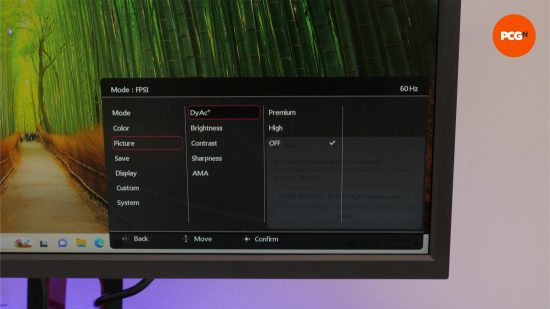
BenQ Zowie XL2566K image quality
Let’s face it, dazzling image quality isn’t the main pursuit of this display. Not only does it have a modest resolution, but the TN tech used in its LCD panel is notorious for having poor viewing angles, middling contrast, and mediocre color reproduction. This monitor is focused on gaming performance over all else, so it simply isn’t going to have exciting image quality.
However, its image still needs to be good enough to provide that all important competitive advantage, and if it can at least produce a half decent looking image when being used for anything other than esports, then that’s a definite bonus.
With its 24-inch screen and 1,920 x 1,080 resolution, you get a pixel density of around 92ppi. That’s quite low, and makes for visible individual pixels at a normal desk viewing distance. That means text can look a touch blocky – especially smaller fonts such as those found on browser navbars – and you generally don’t get the pin sharpness that we often expect from modern screens.
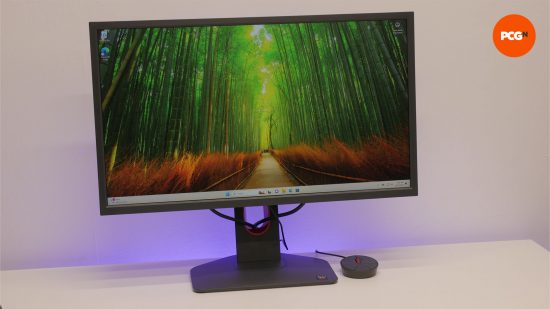
However, this lack of sharpness is in some ways why this screen is so valued for certain games such as CS:GO/CS2. In these twitch shooters, it’s the visual cues of large, easily discernible pixels changing color that can make it easier to register what’s happening on screen. The lower resolution also helps to ensure the latency of the game is as low as possible, but visually it’s not a hindrance either.
However, for games where there’s much more visual clutter or longer viewing distances, the lack of pixels and sharpness is a problem. There simply isn’t the detail to make out whether that distant object is a wavering bit of grass or a head.
Otherwise, this display is as mediocre as you would expect from its TN LCD. Viewing angles are indeed poor, which doesn’t so much mean the image disappears if you slightly move your head in front of it, but it does mean you can get slight shimmering effects, and that certain subtle color transitions can be lost from one corner of the screen to the other.
As for HDR, it’s not even a feature you can enable in Windows with this display. This panel has a maximum claimed contrast ratio of 1,000:1 (the highest we measured was 955:1) and it has no extended color range at all. That means it’ll cover 100% of the sRGB color space (as high as 96.5% coverage and 115.4 volume by our count), but only 70% Adobe RGB and 75% DCI P3 – the color space used in many HDR standards.
The end result is an image that just looks a bit boring. There’s not much punch to the colors, or depth to black levels. The image quality is no better than what we’ve seen on LCDs from 20 years ago in terms of raw performance. Notably, Asus’ 540Hz TN LCD panel does actually include an extended color gamut, so it’s not like BenQ Zowie couldn’t have included this feature. Instead, it chose to just nail down the gaming performance features for non-HDR games.
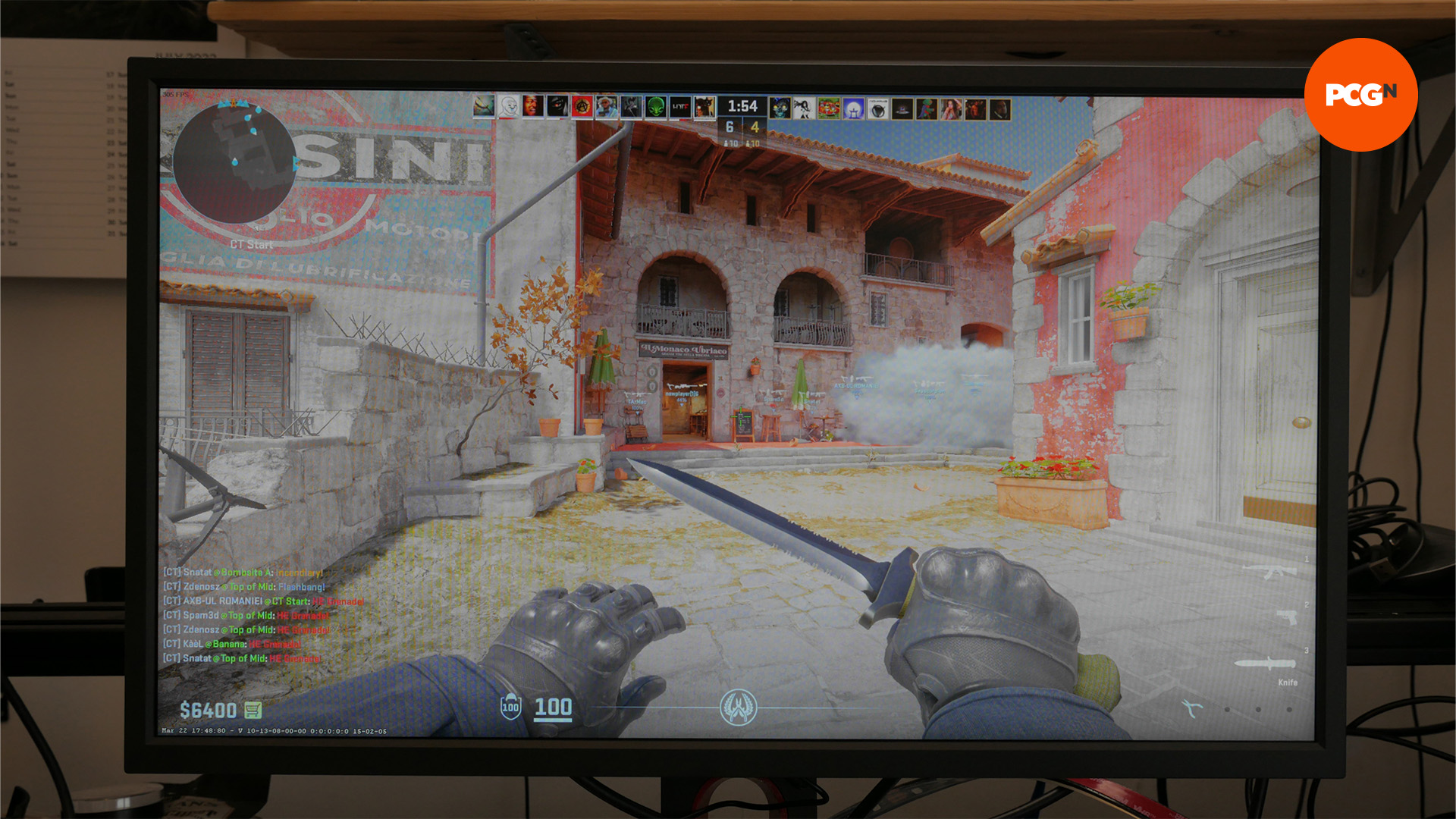
Out of the box, this monitor is set to an Eco mode that lacks brightness (172nits max) and has a very low gamma number (1.96), resulting in a dull and washed out image. Turn this off and the default mode is FPS1 (picture above), which the manufacturer claims is the mode optimized for CS:GO. This mode sets the brightness to 75/100, cranks up the Black Equalizer setting to 5/10 (this brightens dark colors to make it easier to see in darker areas), and turns on the all important Dynamic Accuracy mode.
The resultant image isn’t visually particularly pleasing for most tasks. The color temperature is far too high at 8,283K, contrast is lower than it could be (835:1), gamma is too high, and colors are oversaturated, making for a blue-tinged image, unnatural-looking image with overall bright dark colors.
However, there’s no denying it helps key details standout in competitive games. Dark details are more visible and the unnatural color saturation and blue tinge helps emphasise differences in color (to make object more visible). Meanwhile, for non-competitive gaming, there are modes that look a lot better.
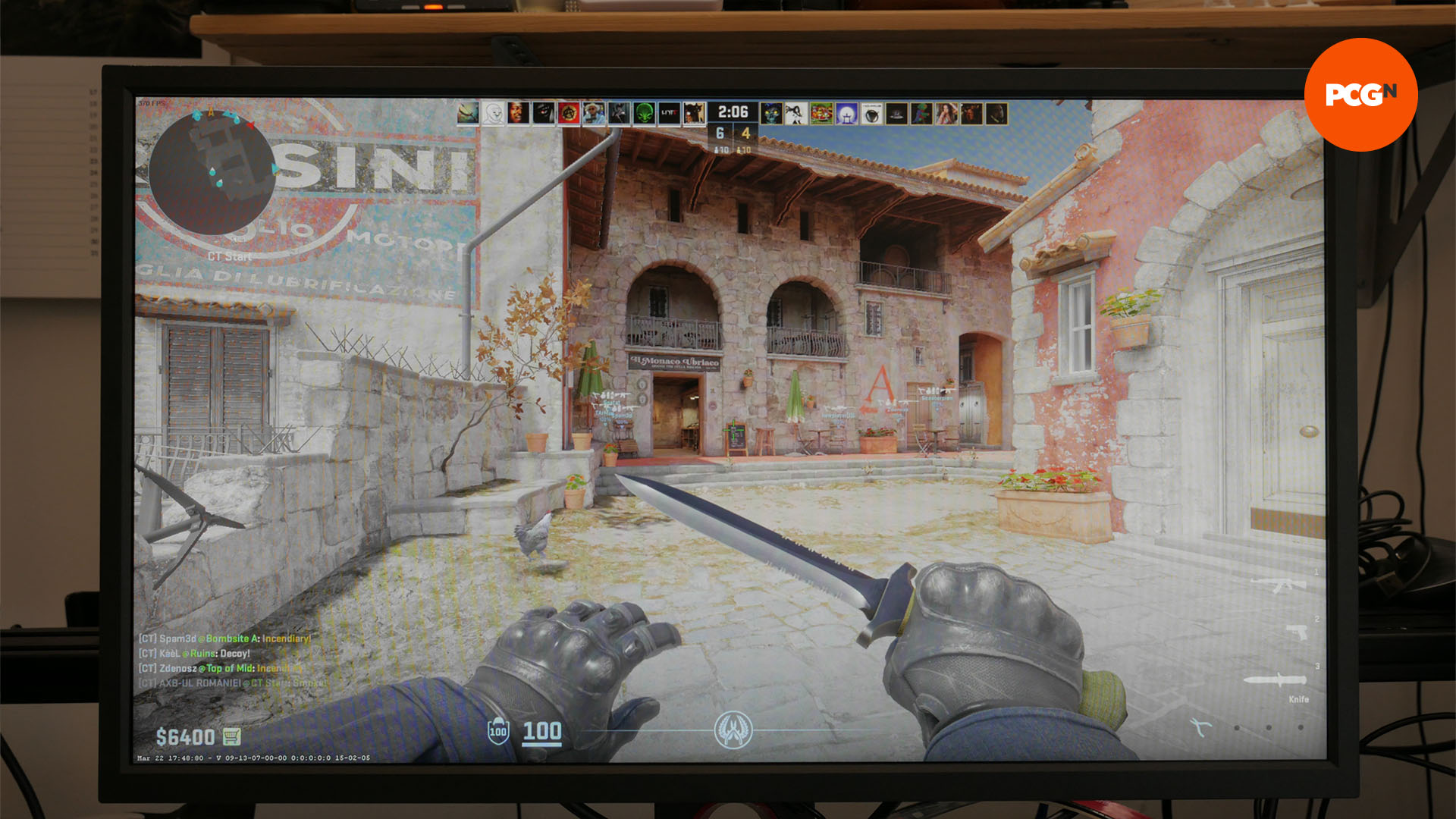
Switch DyAc off, enable the User color mode, and opt for gamma 4 (rather than the default 3) and you get as close to an ideal image as this display will produce (as above). The color temp hits 6,682K, which is much closer to the ideal of 6,500K that is desired for most users, contrast improves, and gamma is better. On our test sample, we tweaked the user color balance from 100 x 100 x 100 to 100 x 98 x 98, and this setting got us a near perfect 6,541K color temp.
The resultant image still isn’t amazing, but it looks reasonably balanced and natural, with a bit more contrast and dynamism than the default. You can see the difference between the default FPS1 mode and the calibrated image above.
BenQ Zowie XL2566K gaming performance
As you would hope, the XL2566K offers excellent gaming performance in general, with its 360Hz refresh rate inherently meaning that, even if this panel’s response time were very poor, you would still get a rapidly-updated image. Thankfully, though, this panel’s response time is decent, though not quite as blazingly fast as you might expect.
Using our OSRTT response time tester, the panel averaged an initial response time of only 6.02ms with AMA turned off, which isn’t underwhelming for a TN panel, though this did result in nearly no color overshoot, so the display’s colors stay accurate. Crank up the AMA/response time setting to High, and the initial response time more than halves to 2.44ms, though color overshoot did jump up, resulting in some inverse ghosting (where you get ghostly trails of opposite color around moving parts of the image).
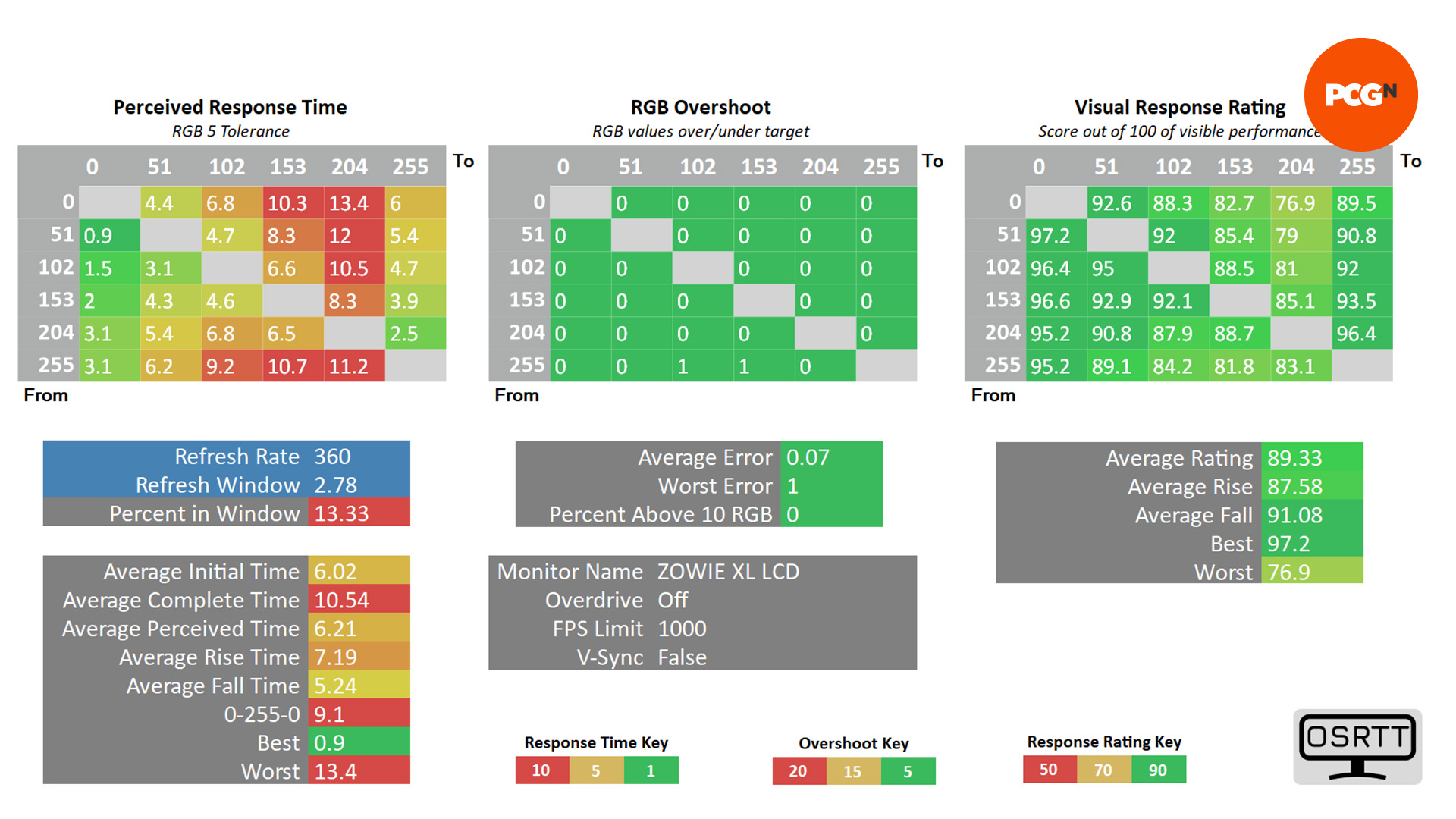
With AMA set to Premium – the default mode for the panel’s default FPS1 Counter-Strike mode – the panel response time drops a little further to 2.11ms, though again color overshoot ramps up further. Despite the overshoot, though, the display doesn’t exhibit really distracting inverse ghosting. It’s just kept in check enough.
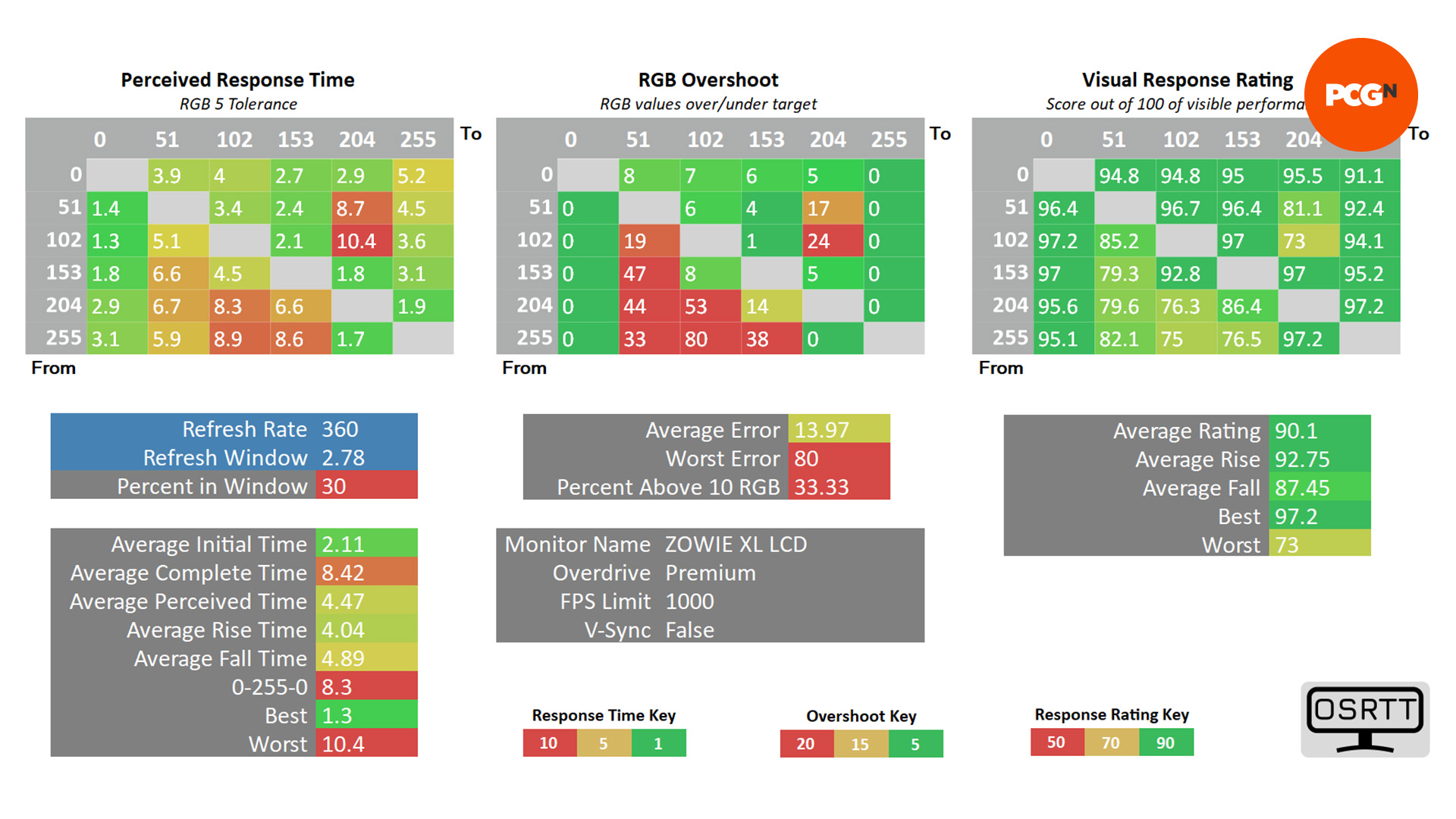
As a point of comparison, the MSI MPG 271QRX QD-OLED measured an average response time of 0.93ms, showcasing the response time advantage of OLED panel technology, and that’s with basically no inverse ghosting.
As a result, even without DyAc, this panel delivers excellent gaming performance in CS2 and Valorant. However, as mentioned earlier, the lack of resolution means that, while Apex Legends is playable, we wouldn’t want to play Warzone or even PUBG on this display, as too much distant detail is lost, ruining your chances of sniping and generally tracking what’s happening across those large maps.
BenQ Zowie XL2566K DyAc
Dynamic Accuracy is in many ways just a rebranded version of the backlight strobing modes that have existed on various gaming monitors for many years. However, BenQ Zowie insists that its tech is among the best out there.
The theory is that by turning off the backlight momentarily – not enough to be noticeable as any kind of flickering – the brain/eye is tricked into essentially refreshing itself, reducing the retention of the previous image that was delivered to your eye. This process primes the eye to register the most up-to-date image as it arrives. It also has the added benefit that the momentary blackness masks any blur/ghosting or inverse ghosting from a slow pixel response time.
The end result is that displays with this type of technology can provide much better clarity in moments of very fast movement. It can even more than bridge the perceived sense of motion clarity across large gaps in refresh rate, with 240Hz screens using backlight strobing appearing to be quicker and sharper than 360Hz models.

Sure enough, turn on DyAc on this display and the motion clarity is fantastic. You can track micro adjustments of your crosshairs or other player movements in a way that’s just so much more difficult on displays without some sort of backlight strobing/black frame insertion. It really does add up to PGL being more than justified in choosing this display for the March 2024 CS2 Major.
What’s more, unlike some basic implementations of this technology, DyAc doesn’t result in a significant drop in the brightness of the screen.
One factor to note about DyAc in general and this display specifically, however, is that it can’t support adaptive sync tech such as FreeSync or G-Sync. As such, you’ll have to rely on Vsync or just playing games with screen tearing. That’s fine for competitive gaming, but it’s good to be able to eliminate tearing and stuttering in other gaming scenarios, where image quality matters more.
BenQ Zowie XL2566K price
The BenQ Zowie XL2566K price is $599, making it a very expensive 1080p gaming monitor, even with its 360Hz refresh rate. You can get displays that offer the same resolutoin/refresh rate combo for half the price. However, they don’t include DyAc or the other tournament-grade additions to this panel. Nonetheless, it’s hard to fully justify the premium here.
BenQ Zowie XL2566K review conclusion
The BenQ Zowie XL2566K fully deserves its place as the go-to gaming monitor for Counter-Strike, with its combination of lightning-fast response times and incredibly quick movement clarity, thanks to DyAc. It simply offers one of the most responsive gaming experiences around, while providing a CS2/Valorant-optimized resolution and screen size, along with extra features that are useful for tournaments and general competitive gaming.
However, this screen is categorically not a jack of all trades. If you want any of the features you otherwise might expect from a $600 screen, such as a larger screen size, a higher resolution, high contrast, a wide color gamut, any semblance of HDR support, or a sleek, low-profile design, well, you don’t get that here. It’s perfectly usable for work, video, and playing other types of games, but countless screens that cost half the price will get you a better experience.
BenQ Zowie XL2566K alternatives
LG 27GR95QE
If you’re after blazing fast response times, but want a better balance of image quality, design, and performance, the LG 27GR95QE is a solid bet. Its 240Hz OLED panel ensures gaming performance is excellent, plus you get a 27-inch size and 1440p resolution. It definitely still has its issues, but it’s a more well rounded display, and it’s the cheapest OLED gaming panel available right now.
Samsung Odyssey G4 24.5inch
At completely the other end of the scale, this Samsung screen offers the same screen size and resolution as the XL2566K but with a 240Hz refresh rate, and you can sometimes get it for just $230 when it’s on offer. It also offers the superior viewing angles and color reproduction that you get from an IPS panel, as well as G-Sync support.
